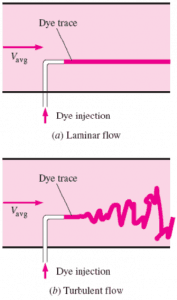Laminar Flow
 In fluid dynamics, laminar flow is characterized by smooth or regular paths of fluid particles, in contrast to turbulent flow, which is characterized by the irregular movement of particles of the fluid. The fluid flows in parallel layers (with minimal lateral mixing), with no disruption between the layers. Therefore the laminar flow is also referred to as streamline or viscous flow.
In fluid dynamics, laminar flow is characterized by smooth or regular paths of fluid particles, in contrast to turbulent flow, which is characterized by the irregular movement of particles of the fluid. The fluid flows in parallel layers (with minimal lateral mixing), with no disruption between the layers. Therefore the laminar flow is also referred to as streamline or viscous flow.
The term streamline flow is descriptive of the flow because, in laminar flow, layers of water flow over one another at different speeds with virtually no mixing between layers. Fluid particles move indefinite and observable paths or streamlines.
When a fluid is flowing through a closed channel such as a pipe or between two flat plates, either of two types of flow (laminar flow or turbulent flow) may occur depending on the velocity, viscosity of the fluid, and the size of the pipe (or on the Reynolds number). Laminar flow tends to occur at lower velocities and high viscosity.
Turbulent Flow
 In fluid dynamics, turbulent flow is characterized by the fluid’s irregular movement of particles (one can say chaotic). In contrast to laminar flow, the fluid does not flow in parallel layers, the lateral mixing is very high, and there is a disruption between the layers. Turbulence is also characterized by recirculation, eddies, and apparent randomness. In turbulent flow, the speed of the fluid at a point is continuously undergoing changes in both magnitude and direction.
In fluid dynamics, turbulent flow is characterized by the fluid’s irregular movement of particles (one can say chaotic). In contrast to laminar flow, the fluid does not flow in parallel layers, the lateral mixing is very high, and there is a disruption between the layers. Turbulence is also characterized by recirculation, eddies, and apparent randomness. In turbulent flow, the speed of the fluid at a point is continuously undergoing changes in both magnitude and direction.
Detailed knowledge of the behavior of turbulent flow regimes is important in engineering because most industrial flows, especially those in nuclear engineering, are turbulent. Unfortunately, the highly intermittent and irregular character of turbulence complicates all analyses. Turbulence is often said to be the “last unsolved problem in classical mathematical physics.”
The main tool available for their analysis is CFD analysis. CFD is a branch of fluid mechanics that uses numerical analysis and algorithms to solve and analyze problems that involve turbulent fluid flows. It is widely accepted that the Navier–Stokes equations (or simplified Reynolds-averaged Navier–Stokes equations) can exhibit turbulent solutions, and these equations are the basis for essentially all CFD codes.